Persona 5 offers a compelling exploration of identity, highlighting characters’ struggles with self-acceptance and societal pressures. The game emphasizes the importance of social relationships in character development and gameplay. Its distinctive art style visually represents these themes, enhancing the narrative’s emotional depth. Together, these elements create an engaging experience that resonates with players.
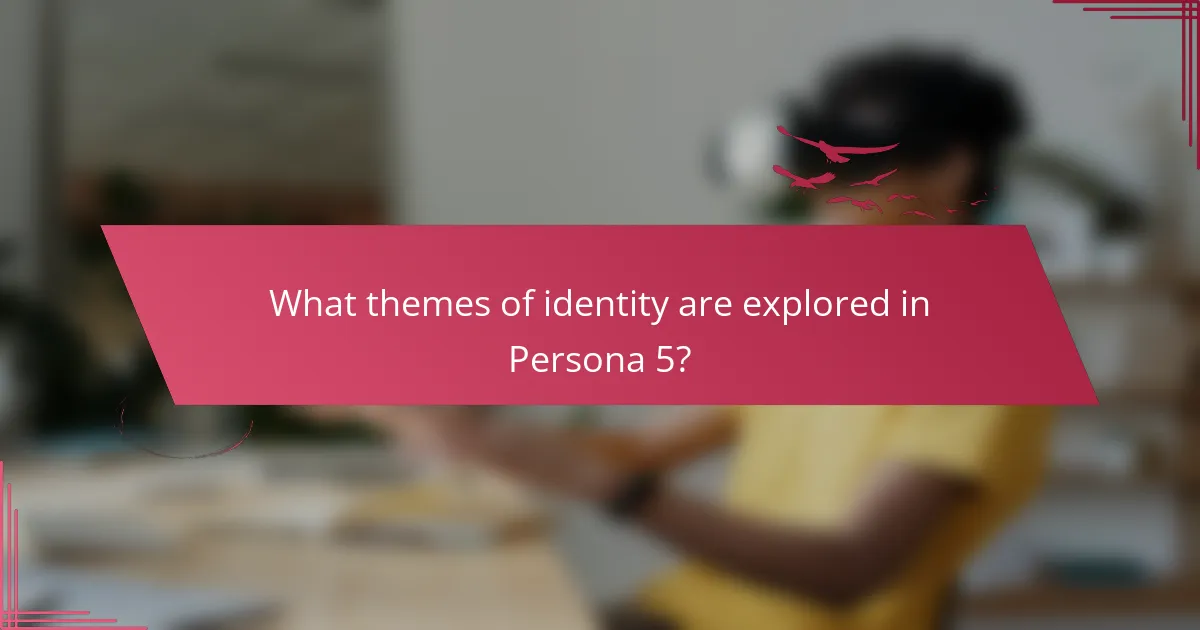
What themes of identity are explored in Persona 5?
Persona 5 explores themes of identity through the characters’ struggles with self-acceptance, societal expectations, and personal transformation. The game delves into the duality of personas, representing the masks individuals wear in different social contexts. Characters like Ren Amamiya face the challenge of reconciling their true selves with societal pressures. The art style enhances these themes, using vibrant visuals to depict the emotional states and inner conflicts of characters. As a result, Persona 5 creates a rich narrative that encourages players to reflect on their own identities and relationships.
How do character arcs reflect personal growth?
Character arcs in Persona 5 illustrate personal growth through transformation and self-discovery. Each character faces unique challenges that reflect their internal struggles and societal pressures. For instance, Ren Amamiya evolves from a misunderstood delinquent to a confident leader, embodying the game’s theme of reclaiming one’s identity. This progression highlights how interpersonal relationships influence personal development, reinforcing the narrative’s focus on social connections and self-acceptance. The art style complements these themes, visually representing the characters’ emotional journeys and growth.
What role does the protagonist’s dual life play in identity formation?
The protagonist’s dual life in Persona 5 significantly influences their identity formation. This duality allows exploration of contrasting social roles, leading to self-discovery. The protagonist navigates between their everyday life as a student and their alter ego as a Phantom Thief. This tension fosters growth and reflection, highlighting the complexity of identity in response to societal expectations. As a result, the protagonist learns to reconcile these facets, ultimately shaping their sense of self.
How do societal pressures influence characters’ identities?
Societal pressures significantly shape characters’ identities in Persona 5. Characters navigate expectations from peers, family, and society, leading to conflicts between their true selves and societal roles.
For instance, Ren Amamiya, the protagonist, faces immense pressure to conform to societal norms while trying to establish his identity as a Phantom Thief. This duality highlights the struggle between personal desires and external expectations.
Additionally, characters like Ann Takamaki experience the impact of beauty standards and social acceptance, which influences their self-perception and actions. The game’s narrative emphasizes how these societal influences can prompt characters to rebel or conform, ultimately shaping their identities and relationships.
The art style further enhances this theme, using visual contrasts to represent the characters’ internal struggles against societal pressures. The vibrant colors of the Phantom Thieves’ personas juxtapose the muted tones of their everyday lives, symbolizing their quest for authentic identity amidst societal constraints.
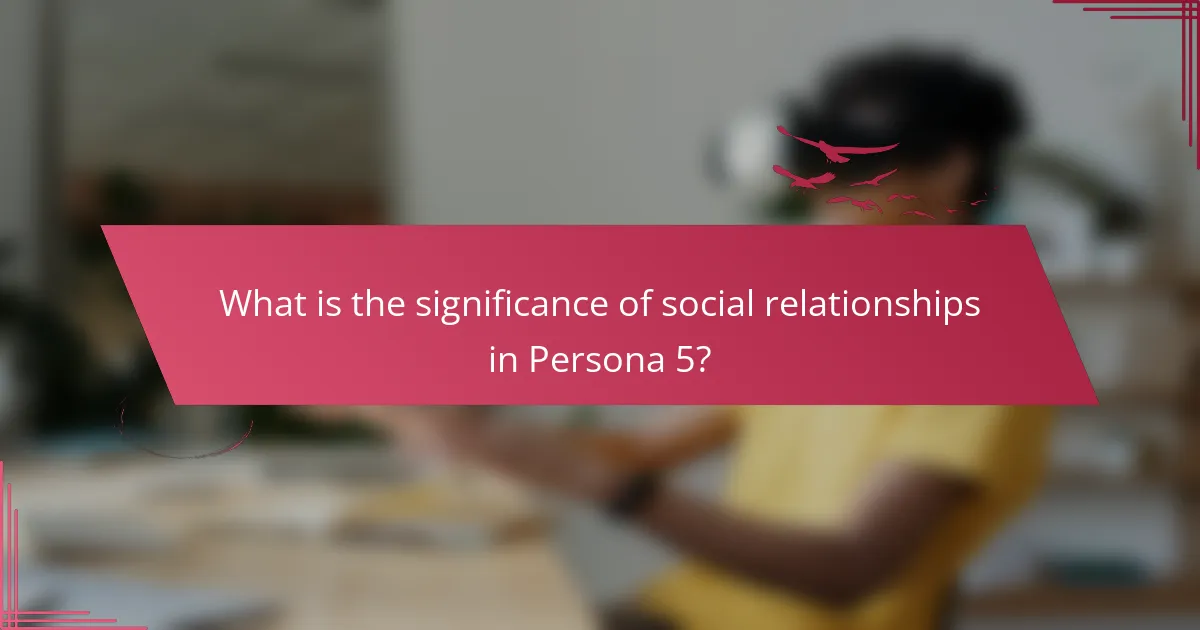
What is the significance of social relationships in Persona 5?
Social relationships in Persona 5 are crucial for character development and gameplay. They enhance emotional depth and influence the protagonist’s journey. Building bonds with characters unlocks new abilities and strengthens the narrative. The game’s emphasis on social connections reflects real-life interactions and personal growth. Engaging with these relationships fosters a sense of community and belonging, enriching the player’s experience.
How do friendships impact character development?
Friendships significantly influence character development in Persona 5 by shaping identity and personal growth. The game’s narrative emphasizes how social relationships foster self-discovery and transformation. Players engage with various characters, each representing unique attributes that contribute to the protagonist’s evolution.
Through interactions, players experience the root attribute of camaraderie, which cultivates resilience and empathy. Unique attributes emerge as friendships deepen, revealing individual backstories and motivations. Rare moments of connection lead to profound character insights, enhancing the overall narrative depth.
These dynamics illustrate how social bonds in Persona 5 not only enhance gameplay but also reflect real-world character development through meaningful relationships.
What are the dynamics of the Phantom Thieves’ teamwork?
The Phantom Thieves exhibit strong teamwork through collaboration, trust, and shared goals. Each member brings unique skills, enhancing their collective effectiveness. Their dynamics reflect a blend of individual strengths and mutual support, which is crucial for overcoming challenges. The trust established among them fosters open communication, allowing for strategic planning and adaptability in various situations. This synergy not only drives their mission but also deepens their personal relationships, highlighting themes of identity and social connection within the narrative.
How do romantic relationships enhance the narrative?
Romantic relationships enhance the narrative in Persona 5 by deepening character development and emotional stakes. These relationships reveal personal growth and the complexities of identity. For example, the protagonist’s interactions with allies foster trust and collaboration, enriching the overall story. Additionally, the game’s art style visually represents these connections, emphasizing emotional moments through vibrant aesthetics. As a result, romantic subplots contribute significantly to the game’s themes of social relationships and self-discovery.
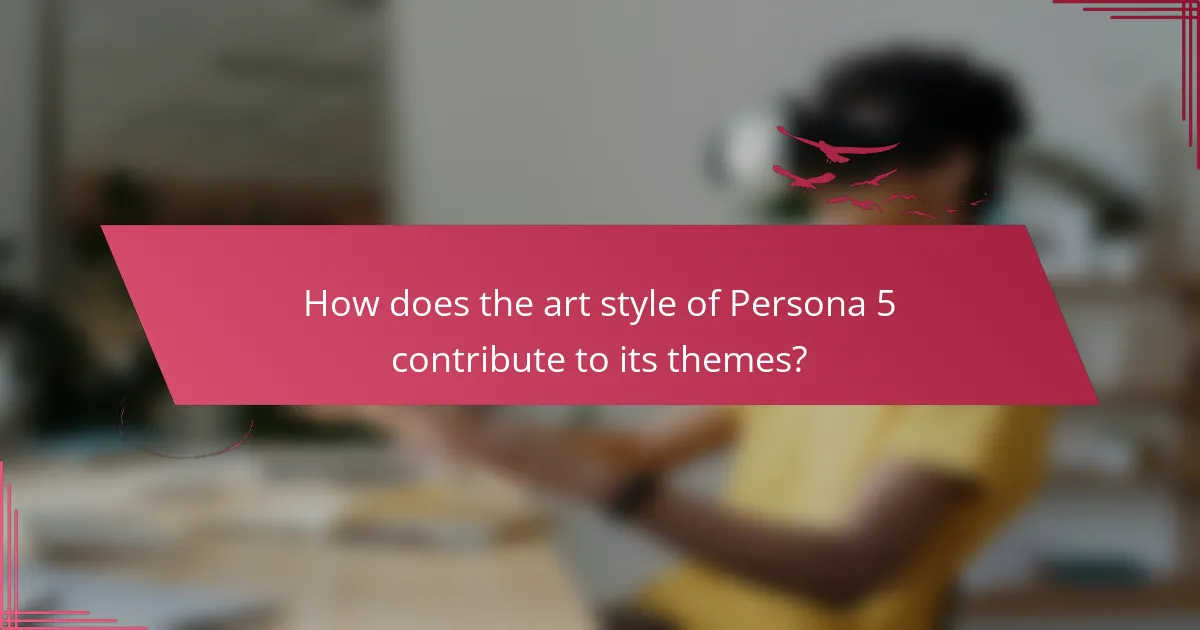
How does the art style of Persona 5 contribute to its themes?
The art style of Persona 5 enhances its themes by visually representing the characters’ inner struggles and societal critiques. The vibrant color palette and unique character designs symbolize individual identity and social relationships. For example, the use of contrasting colors reflects the dichotomy between the protagonists’ true selves and their societal masks. Additionally, the comic book-inspired visuals emphasize the game’s narrative style, reinforcing themes of rebellion against conformity. This artistic approach deepens player engagement, making the exploration of identity and social dynamics more impactful.
What visual elements symbolize character emotions?
Visual elements in Persona 5 symbolize character emotions through color, design, and symbolism. For example, vibrant colors reflect characters’ moods, while unique art styles convey their psychological states. The use of visual motifs, like masks, represents hidden identities and emotional struggles. Additionally, background elements often change to mirror characters’ internal conflicts, enhancing the storytelling experience.
How does the color palette reflect themes of rebellion and conformity?
The color palette in Persona 5 vividly contrasts themes of rebellion and conformity. Bold, vibrant colors symbolize the characters’ defiance against societal norms. In contrast, muted tones reflect the oppressive environment they navigate. This duality enhances the narrative, emphasizing the struggle between individuality and societal expectations. The unique use of color enhances character identities, reinforcing their journeys toward self-discovery.
What role does animation style play in storytelling?
Animation style significantly influences storytelling by shaping character perception, emotional depth, and thematic expression. In “Persona 5,” the vibrant art style enhances themes of identity and social relationships. The unique visual elements reflect the characters’ inner struggles and societal critiques. This connection between animation and narrative facilitates a deeper viewer engagement, allowing for a richer understanding of complex themes.

Which unique attributes set Persona 5 apart from other RPGs?
Persona 5 stands out from other RPGs through its unique exploration of identity, social relationships, and distinctive art style. The game emphasizes character development and personal growth, allowing players to form deep connections with others. This focus on social interactions is complemented by a vibrant, anime-inspired visual aesthetic that enhances the storytelling experience. Additionally, the incorporation of turn-based combat with a stylish presentation sets it apart, creating a memorable and engaging gameplay experience.
How does the game’s narrative structure differ from traditional RPGs?
Persona 5’s narrative structure diverges from traditional RPGs by emphasizing character-driven storytelling and social interactions. The game integrates real-world themes, such as identity and relationships, into its plot, allowing players to shape their narrative experience. This contrasts with conventional RPGs that often prioritize linear quests and combat mechanics. Persona 5’s unique attribute lies in its seamless blend of daily life simulation and dungeon crawling, enriching character development and player engagement. The art style further enhances this experience, creating a visually striking representation of its themes.
What innovative gameplay mechanics enhance player engagement?
Innovative gameplay mechanics in Persona 5 enhance player engagement through dynamic social interactions, strategic turn-based combat, and immersive art style. The game employs a unique blend of life simulation and dungeon crawling, allowing players to build relationships while navigating complex narratives. The visual aesthetics, characterized by vibrant colors and stylized character designs, create an engaging atmosphere that captivates players. Additionally, the Persona fusion system offers a rare depth of customization, enabling players to tailor their gameplay experience uniquely.
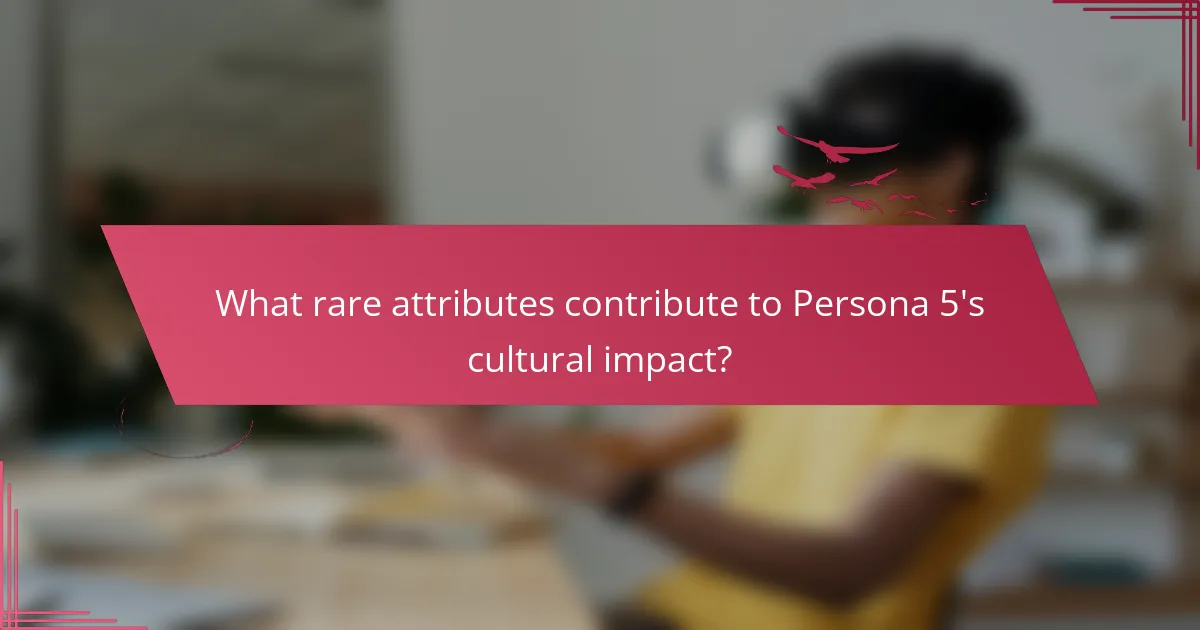
What rare attributes contribute to Persona 5’s cultural impact?
Rare attributes contributing to Persona 5’s cultural impact include its unique art style, which blends anime aesthetics with urban environments, and its innovative narrative structure that incorporates real-time decision-making. Additionally, the game explores complex themes of identity through its character development and social relationships, resonating deeply with players. The incorporation of a distinctive soundtrack further enhances its cultural significance, creating an immersive experience that reflects modern societal issues.
How has Persona 5 influenced other media and games?
Persona 5 has significantly influenced media and games through its exploration of identity, social relationships, and distinctive art style. The game’s narrative depth and character development have set new standards for storytelling in role-playing games.
Its unique blend of traditional turn-based combat and social simulation has inspired other titles to incorporate similar mechanics. For instance, games like Fire Emblem: Three Houses and Danganronpa have adopted relationship-building elements that enhance player engagement.
The striking visual style of Persona 5, characterized by vibrant colors and bold designs, has also made an impact on art direction in various media. This aesthetic has encouraged other developers to prioritize artistic expression in their projects, resulting in visually stunning experiences.
Overall, Persona 5’s influence is evident in the way it has reshaped narrative approaches, gameplay mechanics, and artistic styles across the gaming landscape.
What unique marketing strategies were employed for Persona 5?
Persona 5 employed unique marketing strategies that emphasized its themes and art style. The campaign included collaborations with fashion brands to reflect the game’s identity themes. Interactive social media campaigns engaged fans through polls and character quizzes, enhancing social relationships among players. Limited edition merchandise showcased the game’s distinctive art style, creating buzz and exclusivity. Additionally, promotional events featured live performances and art exhibitions, immersing audiences in the Persona 5 experience.
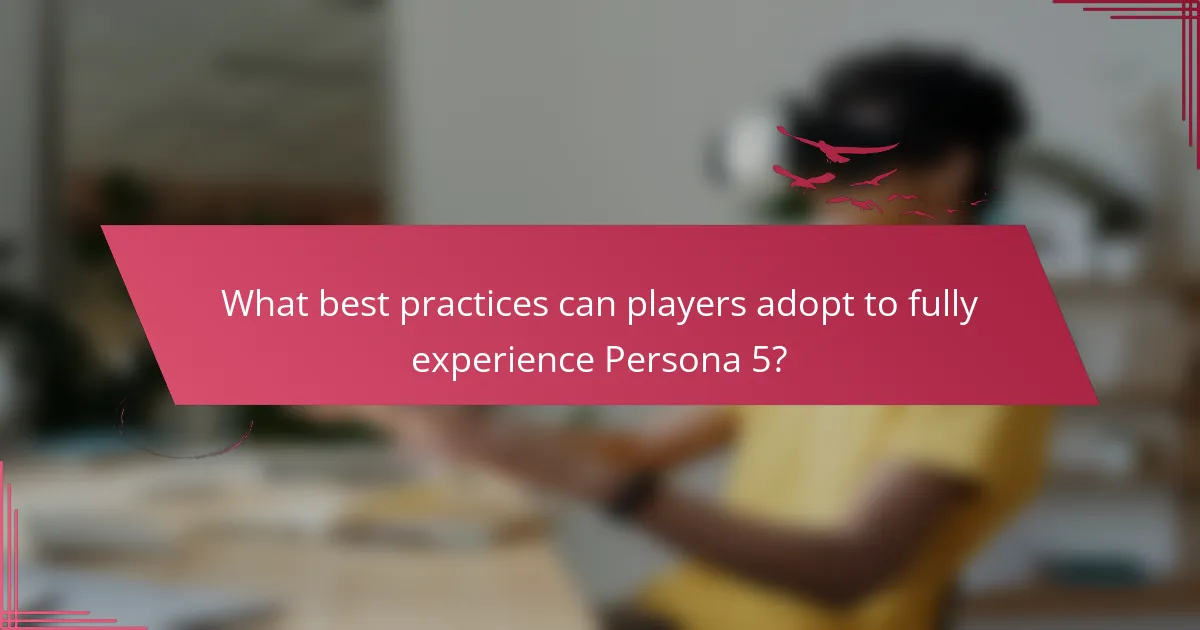
What best practices can players adopt to fully experience Persona 5?
Players can fully experience Persona 5 by engaging deeply with its themes and mechanics. Focus on character development to understand the themes of identity and social relationships. Participate in various in-game activities to enhance social stats, which unlocks new storylines and interactions. Embrace the unique art style by appreciating the visual storytelling and design elements. Explore different narrative paths to experience the game’s rich content and emotional depth.
How to balance social interactions and dungeon exploration effectively?
To balance social interactions and dungeon exploration effectively in Persona 5, prioritize time management. Engage in social activities to strengthen relationships, which enhances character abilities. Simultaneously, allocate specific in-game days for dungeon exploration to ensure progress. This strategy maximizes both social and gameplay elements, allowing players to enjoy the narrative and mechanics fully.
What common mistakes should players avoid in the game?
Players should avoid common mistakes like neglecting character relationships, mismanaging time, and ignoring the art style’s significance. Focusing too much on combat can lead to missed narrative depth. Balancing social interactions and gameplay enhances the overall experience. Additionally, overlooking the unique attributes of each character can diminish strategic advantages.


